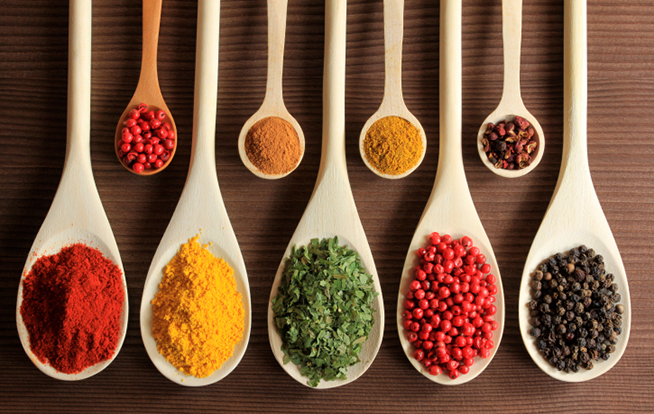9 Spices to Spice Up Your Life and Your Health
By Claire Georgiou, Reboot Naturopath, B.HSc ND
Spices add so much flavour and can make a meal into a lovely taste sensation but did you know spices also have a long list of health benefits? Spices can offer potential cancer reducing properties, reduced pain, improve cardiovascular health, possess anti-microbial benefits and they also contain vitamins, minerals & powerful anti-oxidants.
In herbal medicine we use spices often for all sorts of health ailments which can be given through diet as fresh or dried, liquid herbal tinctures, powders or tablets. Spices are wonderful power houses of specialised nutrients that can support the body through a series of actions that are anti-aging and reduce degenerative inflammatory diseases.
1.) Cinnamon
From the bark of a tropical ever-green tree, this wonderful tasty spice is eaten all over the world in many savoury and sweet dishes. This is also consumed as a tea in some blends. One of my favourite teas is called Bengal spice which is a beautiful combination of cinnamon, cloves, ginger, black pepper, cardamom and nutmeg. These spices in a tea can help cure those late night sweet cravings!
Cinnamon is known to help control blood sugar levels, insulin resistance, Diabetes, aids fat burning and can also be used as a digestive carminative for diarrhea, intestinal colic and nausea and some sources hail it as an excellent anti-septic. But other than all these wonderful properties it tastes so good. I love the recipes that contain cinnamon such as the Sweet P. Juice, Peach Pie Juice and a Homemade hazelnut cinnamon milk.
2.) Turmeric
Turmeric is one of my favourite spices for its powerful list of health benefits and it has been listed as one of the most powerful anti-oxidants world-wide.
Key active ingredients are curcuminoids particularly curcumin. This spice offers a long list of health benefits such as it may help heal ulcers including infections with Helicobacter, improves liver detoxification pathways, prevention of cancer, Alzheimer’s disease and cardiovascular disease and helps reduce cholesterol levels. All these benefits are due to its high anti-oxidant and anti-inflammatory effects. This spice is also used for pain in osteoarthritis and rheumatoid arthritis. Drink up this Orange Turmeric Juice!
3.) Saffron
Saffron is a beautiful coloured spice that is used in soups and warm dishes. The key active ingredient Crocetin, has been studied and shown to improve vision and reduce macular degeneration due to the high carotenoid content, it may reduce depression and large medicinal amounts have been shown to improve feelings of happiness. This spice also has promising cancer prevention benefits.
4.) Ginger
Key active ingredient in ginger is gingerols & shogaols. Herbal texts list uses such as upset stomach, gas, bloating, nausea, motion sickness & morning sickness & nausea and vomiting in chemotherapy. It may reduce pain and inflammation such as osteoarthritis, rheumatoid arthritis & rheumatism, spasmodic period pain. It has also shown to reduce exercise induced muscle soreness. It can also be beneficial in acute infections such as a common cold and respiratory inflammation such as bronchitis & asthma. Ginger is a great addition in many juice recipes.
5.) Chilli
Chilli contains capsaicin, a powerful anti-inflammatory compound that helps relieve pain, improves circulation, enhances memory, used traditionally for coughs and colds, and is showing promise for its anti-cancer properties. Can also assist in weight loss and may reduce blood cholesterol & triglyceride levels. A recent British study found that when applied topically in the form of a patch, capsaicin is useful in reducing pain. And a Japanese study on mice found that taking capsaicin was as effective as exercise when it comes to maintaining body weight.
6.) Cardamon
This spice has been shown to reduce cancer development in animal studies and increase cell death of cancer cells in the colon. This herb can also be used for its mild diuretic benefits in fluid retention and may be useful for high blood pressure.
7.) Cumin
This is a newly studied spice that is showing promise for lowering blood glucose levels and used for its natural anti-bacterial effects in the digestive system. A phytonutrient in cumin called apigenin inhibited metastasis of lung melanoma cells and angiogenesis of tumor cells.
8.) Paprika
Just looking at this spice you know it’s going to be full of goodness. The depth of colour is always a nutrient and anti-oxidant give away. This is made from a type of pepper (cayenne annuum) that is very high in Vitamin C and improves iron absorption of the other ingredients in your meal. This herb has been shown to help digestion, act as an anti-bacterial in the stomach and small intestine and improves circulation.
9.) Cloves
One of the key active ingredients is the essential oil eugenol. In traditional herbal text, clove offers health benefits for reducing intestinal worms, digestive discomfort such as nausea, colic, bloating and can be used topically for toothache, and as a gargle for pharyngitis , laryngitis and bad breath.
Need more ideas to spice up your daily regimen? Check out the most recent episode of The Joe Show all about Exceptional Juicing!
Herbal texts as references
Principles and Practices of Phytotherapy, Kerry Bone; Simon Mills 2nd Edition 2012
Phytotherapy Desk Reference M.Thomsen, H. Gennat. 4th Edition. 2012
